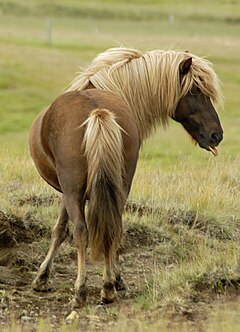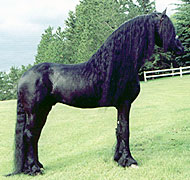Picture a Viking riding a horse and what comes to mind? A burly guy in armor on a large, noble steed? Odin riding Sleipnir across the sky? Well, you’re wrong, and you should feel badly about it. You see, the Hollywood image of a Viking’s horse looks something like this:
Or even this:
But the first horse is a Friesian, a breed from the Netherlands. Their ancestors carried knights around, not Vikings. Someone needs to tell this to Hollywood. They put Friesians in any film they can. Why? Because they’re cool looking. Need a horse to play Pegasus in Clash of the Titans? Friesian. Need an Andalusian (a Spanish breed) for The Mask of Zorro? Friesian. Need a Bucephalus for Alexander the Great? Friesian. You get my point. As for the second horse. That’s a Shire, an English draft breed.
So what did a Viking’s horse look like? Well, let’s consider what they used horses for. In most other cultures, horses were used in war. But the Vikings preferred to jump into their longships, sail right up to an enemy beach, and raid the nearest Monastery, all while on foot. They might have had a hard time doing that if the shallow ships were full of horses too. This isn’t to say that Vikings never used horses in battle, but battle was not their primary use. More commonly, Vikings used horses for travel and draft work. Geography also plays a role in shaping these horses. Freezing land with poor grazing tends to breed small, tough, hairy horses…or ponies. And that’s what happened. The mighty Vikings produced cute, fuzzy little ponies. Let’s take a look at two modern breeds of Viking origin:
The Icelandic Pony (or Icelandic Horse, if you’re in Iceland), is a cute little baby precious that has a fifth gait, called the tölt (most horses have four gaits; walk, trot, canter, gallop). They come in a variety of colors and are the only breed of “horse” allowed in Iceland.






And here is the Fjord Pony, a hardy dun-coated creature from Norway. One of the most easily identifiable characteristics of this breed is its standing (mohawk) mane.
So now we know. Never again shall we fall for the lies of popular culture…when they are both Viking and horse related. Don’t even get me started on the Greeks or Romans.




I will forever see giant burly manly men romping around on too-tiny fuzzy ponies now, when I think of Vikings. This is a win.
ReplyDeleteGet the movie Beowulf and Grendal. Filmed on Iceland, the Vikings are riding the only horse breed available, the Icelandic Horse.
DeleteI get your point. It is all true. But fresians are mostly used because of their nature. Because they are very kind to new riders and very willing horses, good looks are only addition. I know a man, that trains movie horses and most of his horses are fresians, because of those reasons. So I agree with you, but these movies never claimed to be historically accurate :).
ReplyDeleteFriesian are used mainly for their looks and gait. Most are very docile but actually, THAT is the "addition" as you put it. Remember in the 80's and 90's when the trendy breed of horse in every movie was Andalusian?? The only movie from that time with a Friesian as the "main" horse was Ladyhawk, with Rutger Hauer and Michelle Pfeiffer. There's also a stunning Andalusian in one of the last scenes. On another note.. Movies also tend to use several different horses (often for the same role, like they also do with dogs!!) or how about when you see an actor who's a really shitty rider?! Hollywood. I don't think their aim is accuracy in most productions... I think the main goal is simply entertainment!!
DeleteHi, as an American that has Icelandic horses. They are short, but can carry 1/3 of their own weight.
ReplyDeleteAlso,the five gaits are walk, trot, canter, pace.
These horses are strong, intelligent, brave and respectful. They are used in film anytime movies are film on location in Iceland.
For more information on this incredible breed please goto USIHC.org.
The 5th gait is known as tolt here in Scotland I believe pace is an American term?
DeleteAs others have pointed out already, it's called a tölt in every Europe. Americans can't pronounce the umlaut so they call it pace. I'm an American who grew up in Europe and was raised bilingual.
DeleteThat is false. The Icelandic horse has 2 extra gaits, the tölt and the pace. In America, when other breeds tölt it is called the rack. For Icelandics, though, it is always tölt. I am an Icelandic breeder in America and no one every calls the tölt a pace.
DeleteIt's true, though, the tölt is their other gait, not the pace.
ReplyDeleteBoth the tölt and pace are extra gaits. They are the only truly 5 gaited horse breed in the world. They walk, trot, tölt, canter/gallop, and pace. Other horse breeds usually just walk, trot, and canter/gallop
Deletehave any of you watched vikings!?, when they use horses they always use a scandinavian derived breed such as fjords, icelandics, Knabstruppers on occasion,Frederikborgs,and so on and so forth, dont listen to this guy, he should really check his info before he writes a shit article.
ReplyDeleteI have not but have really wanted to start watching it. I saw the first few episodes and I really wanted to like it TBH but couldn't get into it. It's so up my alley tbough, that every time I see the commercials for it, I want to give it another try!! Now that you mentioned their level of accuracy, I definitely will check it out!! However, that's still one of the only shows that rises to that level. The author of this article is speaking generally and not about any one specific show, making this a very accurate article. In case no one's realized, I'm a stickler for accuracy!!!
DeleteI have to say, as an owner and breeder of Icelandic horses, they are anything but "cute little baby precious" as you naively referred to them in the article, and they are called horses both inside and outside of Iceland. They are 4 or 5 gaited horses, and their gaits are walk, trot, tölt, canter/gallop, and pace, not just tölt. Also, gallop is considered the same gait as the canter usually. They are also not "cute fuzzy little ponies". Icelandic horses are a strong breed of horse that are usually around 13-14 hands and have a double coat, but they are not ponies. The Icelandic horse is a long lived, hardy breed that has participated in long distance races such as the Great American Horse Race and are commonly used in endurance riding. They also can be great jumpers and are seen in almost every discipline due to their intelligence and versatility. When I ride on trails, I can't usually ride with people that don't have Icelandics because the other breeds are too slow to keep up and those "noble steeds" usually spook in terror when they see the "cute little baby precious" tölting. This article was very poorly written and misinformed. Please do your research next time.
ReplyDelete